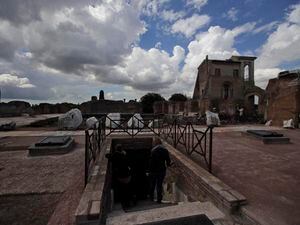History goes underground as Nero’s opulent palace reopens after renovation
Visitors must descend underground to view the rooms and gardens of the residence, covered over the centuries by other buildings and debris.

The first palace built by Rome’s most notorious emperor has reopened to the public after an extensive renovation.
Visitors to Nero’s Domus Transitoria (Transit House) must descend underground to view the rooms and gardens of the residence.

The site has been covered over the centuries by other buildings and debris.
It opened on Friday after a decade of structural work and renovations.

Domus Transitoria was criticised even by Nero’s contemporaries for its opulence.
It featured inlaid marble, frescoed walls and ceilings, as well as trimmings of gold and precious gems.

Built on the Palatine Hill almost 2,000 years ago, it predated the more famous Domus Aurea (Golden Palace).
Alfonsina Russo, general manager of the Colosseum archaeological park, said “Nero wanted an atmosphere that expressed his ideology, that of an absolute ruler, an absolute monarch”.





